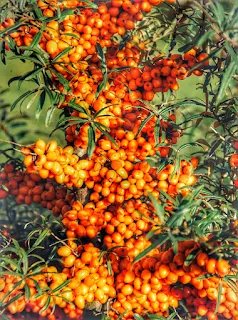The Sea-buckthorn is a versatile and hardy bush, primarily found in the Northern Regions of Pakistan, including Gilgit, Ghizar, Ganche, Astore, Skardu, Baltistan, and Hunza. For centuries, it has been used as a natural remedy to relieve coughs, improve digestion, enhance blood circulation, and reduce pain. Despite its numerous benefits, Sea-buckthorn remains underutilized, even though it covers over 5,000 acres with an annual production of around 120kg per acre. Previously, the Pakistan Council for Scientific and Industrial Research (PCSIR) developed and promoted various Sea-buckthorn products and conducted capacity-building projects in the Skardu region to harness its potential.
555
Locally, Sea-buckthorn is mainly used as firewood, fencing, fodder, and fertilizer. However, its potential as a medicinal plant, food source, and income generator has not been fully recognized. Recently, the Pakistan Agriculture Research Council (Parc) has been promoting Sea-buckthorn products in the Northern Regions through various initiatives.
Sea-buckthorn is an environmentally friendly plant due to its ability to withstand harsh weather and its extensive root system, which fixes nitrogen in the soil, improving fertility and aiding in the recovery of barren lands. It also serves as a "nurse plant," supporting the growth of other vegetation. Its strong root network helps prevent landslides, and its adaptability, rapid growth, and resilience make it ideal for soil conservation, improvement, and land restoration. Additionally, many birds and animals depend on Sea-buckthorn for food and shelter.
atOptions = {
'key' : '056f6e70fdf578cd9ce44f31364fe326',
'format' : 'iframe',
'height' : 90,
'width' : 728,
'params' : {}
};
class="separator" style="clear: both;">Beyond its ecological benefits, Sea-buckthorn has significant economic, biochemical, and nutritional value. Its fruits are rich in vitamins, particularly vitamin C, surpassing many other fruits and vegetables. The fruit pulp, high in medicinal oil, is recommended for treating burns and skin issues caused by radiation therapy. Recent clinical studies in China have shown promising anti-cancer properties of Sea-buckthorn oil. The oil, juice, and extracts from its seeds, leaves, and bark have been used to treat high blood lipids, eye diseases, gum infections, and cardiovascular conditions like hypertension and heart disease. Its therapeutic applications include cancer treatment, cardiovascular risk reduction, gastrointestinal ulcers, skin problems, and liver protection.The plant’s seeds, rich in iron and phosphorus, mature in September and October. Flavonoids, found in the fruit pulp, leaves, and oil, have significant medicinal value. Sea-buckthorn can be processed into various products like jams, jellies, syrups, squash, and soap. Its leaves, containing 23% protein, are used as fodder, and the byproducts of processing can also serve as animal feed. The leaves are also used to make tea.
Despite its potential, local communities in the Northern Regions are hesitant to fully utilize Sea-buckthorn due to the labor-intensive harvesting process, high labor costs, and expensive product prices. Manual berry collection is challenging because of the dense thorns on each branch, and farmers cannot afford advanced harvesting techniques used in developed countries.
With abundant Sea-buckthorn resources in its native regions, there is potential for collection and export to Europe, America, and Canada. Awareness campaigns are needed to promote Sea-buckthorn as an economic crop. Farmers cultivating the plant should receive incentives, such as subsidized rates for their produce. Extensive research and studies are also necessary to explore its large-scale use and benefits for local communities.
Expanding Sea-buckthorn cultivation could generate income, provide fuelwood, and help alleviate poverty in the Northern Regions. By tapping into its potential, communities can access its valuable products and improve their








0 Comments